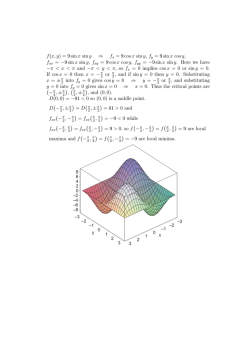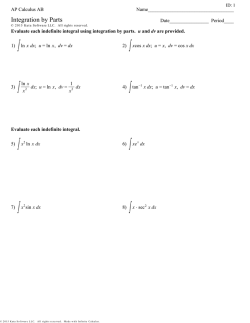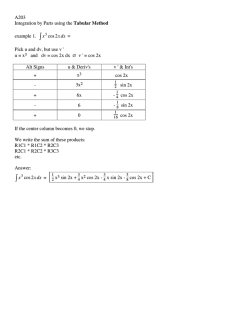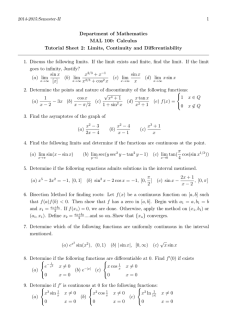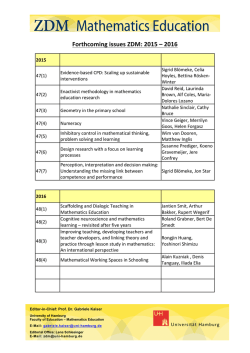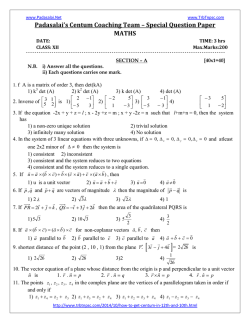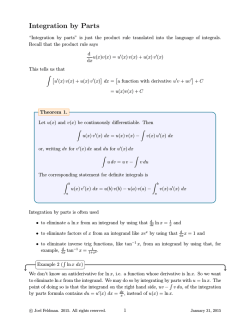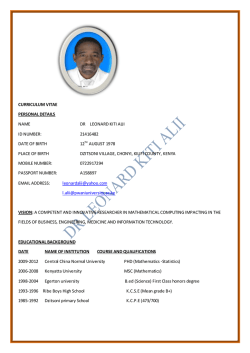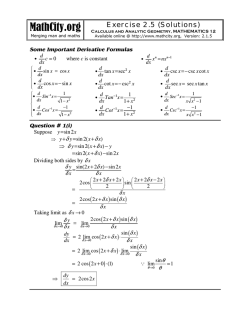
ukuhlolwa kwelizweloke komnyaka nomnyaka 2014 igreyidi 3
NATIONAL SENIOR CERTIFICATE GRADE 12 MATHEMATICS P3 NOVEMBER 2009 MARKS: 100 TIME: 2 hours This question paper consists of 9 pages, 1 information sheet and 3 diagram sheets. Copyright reserved Please turn over Mathematics/P3 2 NSC DoE/November 2009 INSTRUCTIONS AND INFORMATION Read the following instructions carefully before answering the questions. 1. This question paper consists of 11 questions. Answer ALL the questions. 2. Clearly show ALL calculations, diagrams, graphs et cetera, which you have used in determining the answers. 3. An approved scientific calculator (non-programmable and non-graphical) may be used, unless stated otherwise. 4. If necessary, answers should be rounded off to TWO decimal places, unless stated otherwise. 5. Diagrams are NOT necessarily drawn to scale. 6. THREE diagram sheets for answering QUESTION 5.1, QUESTION 5.3, QUESTION 8.1, QUESTION 8.2, QUESTION 9, QUESTION 10 and QUESTION 11 are attached at the end of this question paper. Write your centre number and examination number on these sheets in the spaces provided and insert them inside the back cover of your ANSWER BOOK. 7. Number the answers correctly according to the numbering system used in this question paper. 8. It is in your own interest to write legibly and to present the work neatly. Copyright reserved Please turn over Mathematics/P3 3 NSC DoE/November 2009 QUESTION 1 Consider the sequence 1; 1; 2; 3; 5; 8; … 1.1 Write down a recursive formula for the sequence. (2) 1.2 One of the terms in the above sequence is 233. Write down the next term. (3) [5] QUESTION 2 At a local high school there are 1 200 boys and girls altogether. The management of the school proposes to introduce a special school blazer for learners who have achieved excellence at the highest level in sport, cultural activities and academics. The school management asked the Representative Council of Learners (RCL) to conduct a survey to assess learner responses to this proposal. From past experience the RCL agreed that a sample size of 20% would be adequate for this survey. Nandi, the RCL chairperson, suggested that the names of each of the learners in Grade 8 to Grade 12 be arranged in alphabetical order. From each grade list, the names of exactly the same number of learners should be selected at random to form the sample. Sam, the RCL deputy chairperson, suggested that the names of all the learners at the school be arranged in alphabetical order and from this list the required number of names be selected at random to form the sample. 2.1 Determine the number of learners required for the sample. (1) 2.2 Do you think that the sample size chosen will be sufficient to draw a valid conclusion? Motivate your answer. (2) Do you think that Nandi's method of sampling is more representative of the school's population than Sam's method of sampling? Motivate your answer. (2) 2.3 2.4 Name ONE important criterion that was overlooked by both Nandi and Sam in obtaining a sample. Copyright reserved Please turn over (1) [6] Mathematics/P3 4 NSC DoE/November 2009 QUESTION 3 The members of a local gym had to undertake a fitness test. The performance scores were analysed and found to follow a normal distribution with a mean of 100 and a standard deviation of 15. 3.1 Approximately what percentage of scores lie between 85 and 115? (2) 3.2 If a performance score between 115 and 130 indicates that a member is fit, approximately what percentage of members fall in this category? (2) 3.3 If there are 500 members at the local gym, how many of them would you expect to score more than 130? (2) [6] QUESTION 4 Figures obtained from a city's police department seem to indicate that of all the motor vehicles reported stolen, 80% were stolen by syndicates to be sold off and 20% were stolen by individual persons for their own use. Of those vehicles presumed stolen by syndicates: • • • 24% were recovered within 48 hours 16% were recovered after 48 hours 60% were never recovered Of those vehicles presumed stolen by individual persons: • • • 38% were recovered within 48 hours 58% were recovered after 48 hours 4% were never recovered 4.1 Draw a tree diagram for the above information. (5) 4.2 Calculate the probability that if a vehicle were stolen in this city, it would be stolen by a syndicate and recovered within 48 hours. (2) 4.3 Calculate the probability that a vehicle stolen in this city will not be recovered. Copyright reserved Please turn over (3) [10] Mathematics/P3 5 NSC DoE/November 2009 QUESTION 5 A learner conducted an experiment to investigate the relationship between age and resting heart rate (in beats per minute). He sought the assistance of the local clinic. The information for 12 people is shown in the table below. Age 59 32 42 50 22 39 21 20 27 40 29 47 Resting heart rate (beats per minute) 88 74 74 93 85 71 78 82 70 75 95 75 5.1 Represent the data in a scatter plot. (3) 5.2 Determine the equation of the least squares line. (4) 5.3 Draw the least squares line on the scatter plot. (2) 5.4 Calculate the correlation coefficient for the data. (2) 5.5 Use the correlation coefficient to comment on the relationship between age and the resting heart rate. (2) 5.6 If a learner uses the least squares line to predict the resting heart rate of a 45-year-old person, will his answer be reliable? Motivate your answer. (2) [15] QUESTION 6 The data below was obtained from the financial aid office at a certain university. Undergraduates Postgraduates TOTAL 6.1 6.2 RECEIVING FINANCIAL AID 4 222 1 879 6 101 NOT RECEIVING FINANCIAL AID 3 898 731 4 629 TOTAL 8 120 2 610 10 730 Determine the probability that a student selected at random is ... 6.1.1 receiving financial aid. (2) 6.1.2 a postgraduate student and not receiving financial aid. (2) 6.1.3 an undergraduate student and receiving financial aid. (2) Are the events of being an undergraduate and receiving financial aid independent? Show ALL relevant workings to support your answer. Copyright reserved Please turn over (4) [10] Mathematics/P3 6 NSC DoE/November 2009 QUESTION 7 Consider the digits 1, 2, 3, 4, 5, 6, 7 and 8 and answer the following questions: 7.1 How many 2-digit numbers can be formed if repetition is allowed? (2) 7.2 How many 4-digit numbers can be formed if repetition is NOT allowed? (3) 7.3 How many numbers between 4 000 and 5 000 can be formed? (3) [8] QUESTION 8 8.1 In the diagram below, O is the centre of the circle. K, L and M are points on the circumference of the circle. M K O L ˆ M = 2KLˆM . Prove that the obtuse angle at O, KO Copyright reserved (6) Please turn over Mathematics/P3 8.2 7 NSC DoE/November 2009 In the diagram below, O is the centre of the circle. P, Q, R and S are points on the circumference of the circle. TOQ is a straight line such that T lies on PS. ˆ = x. PQ = QR and Q 1 Q 2 1 x P 1 O 1 2 2 1 2 3 R T S 8.2.1 Calculate, with reasons, Pˆ1 in terms of x. 8.2.2 Show that TQ bisects P Q R. (3) 8.2.3 Show that STOR is a cyclic quadrilateral. (3) [15] (3) ∧ QUESTION 9 O is the centre of the circle below. OM ⊥ AC. The radius of the circle is equal to 5 cm and BC = 8 cm. O B A M C 9.1 ˆ A. Write down the size of BC 9.2 Calculate: (1) 9.2.1 The length of AM, with reasons (3) 9.2.2 Area ΔAOM : Area ΔABC (3) Copyright reserved Please turn over Mathematics/P3 8 NSC DoE/November 2009 [7] Copyright reserved Please turn over Mathematics/P3 9 NSC DoE/November 2009 QUESTION 10 In the figure below, GB || FC and BE || CD. AC = 6 cm and AB = 2. BC A G H B F E C D 10.1 10.2 Calculate with reasons: 10.1.1 AH : ED (4) 10.1.2 BE CD (2) If HE = 2 cm, calculate the value of AD × HE. Copyright reserved (2) [8] Please turn over Mathematics/P3 10 NSC DoE/November 2009 QUESTION 11 In the figure below, AB is a tangent to the circle with centre O. AC = AO and BA || CE. DC produced, cuts tangent BA at B. A 1 E 2 2 3 1 2 3 4 1 F 4 B 2 O 1 3 C 2 1 D 11.1 ˆ =D ˆ . Show C 2 1 (3) 11.2 Prove that ΔACF ||| ΔADC. (3) 11.3 Prove that AD = 4AF. (4) [10] TOTAL: Copyright reserved 100 Mathematics/P3 DoE/November 2009 NSC INFORMATION SHEET: MATHEMATICS − b ± b 2 − 4ac x= 2a A = P (1 + ni ) A = P (1 − ni ) A = P (1 − i ) n n n ∑1 = n ∑i = i =1 i =1 n ∑ ar i −1 = i =1 F= ( ) a r n −1 r −1 [ ; ∑ ar n( n + 1) 2 i −1 = i =1 ] x (1 + i ) − 1 i n ∞ r ≠1 P= A = P (1 + i ) n n ∑ (a + (i − 1)d ) = 2 (2a + (n − 1)d ) n i =1 a ; −1 < r < 1 1− r x[1 − (1 + i )− n ] i f ( x + h) − f ( x ) h h→ 0 f ' ( x) = lim ⎛ x + x 2 y1 + y 2 ; M ⎜⎜ 1 2 2 ⎝ d = ( x 2 − x1 ) 2 + ( y 2 − y1 ) 2 y = mx + c y − y1 = m( x − x1 ) m= ⎞ ⎟⎟ ⎠ y 2 − y1 m = tan θ x 2 − x1 ( x − a )2 + ( y − b )2 = r 2 In ΔABC: a b c = = sin A sin B sin C a 2 = b 2 + c 2 − 2bc. cos A area ΔABC = 1 ab. sin C 2 sin(α + β ) = sin α . cos β + cosα .sin β sin(α − β ) = sin α . cos β − cosα . sin β cos(α + β ) = cosα . cos β − sin α . sin β cos(α − β ) = cosα . cos β + sin α . sin β ⎧cos 2 α − sin 2 α ⎪ cos 2α = ⎨1 − 2 sin 2 α ⎪2 cos 2 α − 1 ⎩ sin 2α = 2 sin α . cos α 2 n x= ∑ fx n P( A) = n( A) n(S ) yˆ = a + bx Copyright reserved σ2 = ∑ (xi − x ) i =1 n P(A or B) = P(A) + P(B) – P(A and B) b= ∑ ( x − x )( y − y ) 2 ∑ (x − x) Mathematics/P3 DoE/November 2009 NSC CENTRE NUMBER: EXAMINATION NUMBER: DIAGRAM SHEET 1 QUESTIONS 5.1 AND 5.3 QUESTION 8.1 M K O L Copyright reserved Mathematics/P3 DoE/November 2009 NSC CENTRE NUMBER: EXAMINATION NUMBER: DIAGRAM SHEET 2 Q QUESTION 8.2 2 1 x P 1 O 2 1 2 1 2 3 R T S QUESTION 9 QUESTION 10 A O B G A H M B F C E C D Copyright reserved Mathematics/P3 DoE/November 2009 NSC CENTRE NUMBER: EXAMINATION NUMBER: DIAGRAM SHEET 3 QUESTION 11 A 1 E 2 2 3 1 2 3 1 4 4 F B 2 O 1 2 1 D Copyright reserved 3 C
© Copyright 2025
